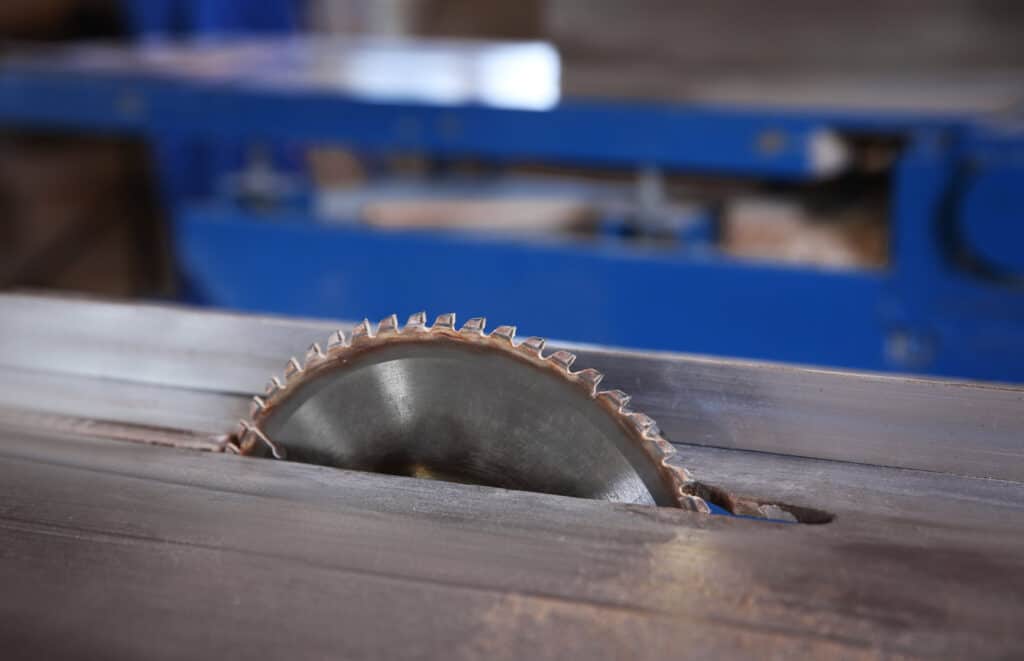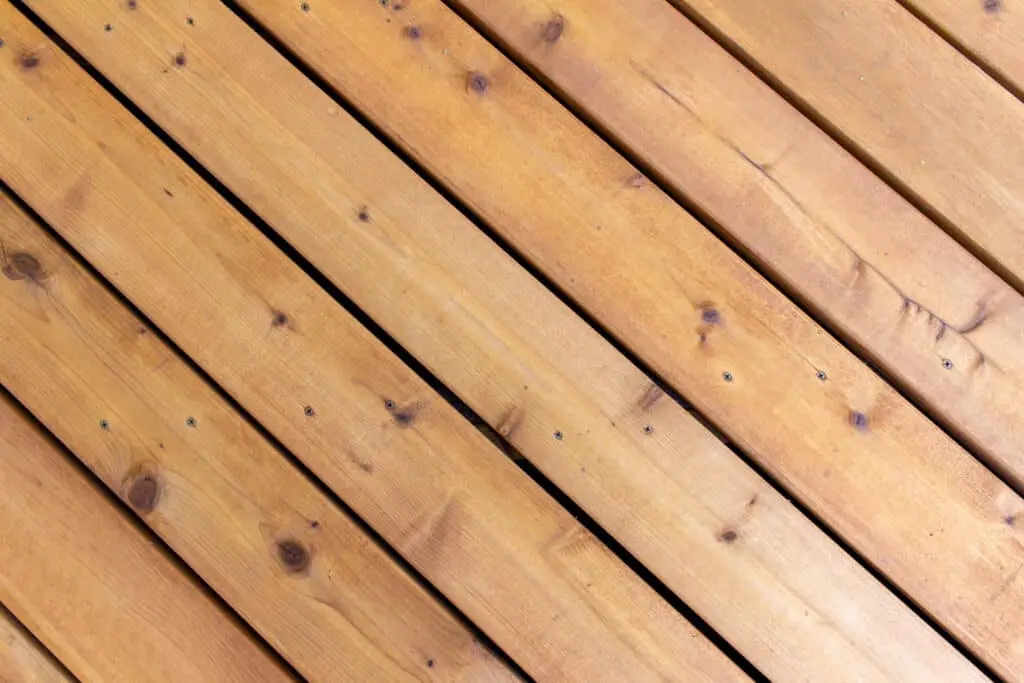Woodworking is a common hobby, but how do you get a perfectly straight edge while woodworking?
In order to get perfectly straight edges while woodworking, use a jointer, mark lines to cut the edge, use a level, and sand the edges. Also, use a band saw or a table saw. These saws often have markings to guide straight cuts, and these markings can be used to cut edges to be perfectly straight.
Now that you know what tools to use, you may be wondering how they can help you cut the edges perfectly.
Use a Jointer
A jointer is a great tool to use when you need to make a perfectly straight edge on wood. They often help people ensure that edges are square. Jointers are large tables with a large upright metal piece on one side of it so you can press the piece of wood flush up against it and see if the edges of the wood are perfectly straight.
However, woodworking jointers are very expensive. Jointers range in price from $284 to $1,700, and they take up a lot of space. If you work with wood frequently and want to ensure that the wood you work with has perfectly straight edges, then a jointer is a great tool for you to use. However, if you rarely work with wood but still want the wood that you do work with to have perfectly straight edges, I recommend using a different tool that is cheaper and takes up less space in your shop.
Mark Straight Lines
If you want to cut a perfectly straight edge on wood, mark where to cut before you start cutting. In order to mark a straight line, use a normal ruler or a triangle ruler. A measuring tape will work as well if you want to use the edge of it to help you mark straight lines. However, measuring tapes may shift as you use them to draw a line, so I recommend using a ruler or other hard, straight, and flat item rather than a measuring tape.
To mark the lines so that you can see them while you are cutting the wood, use a sharpie or another permanent marker. You can also use a pen or another marking tool, but a permanent marker works the best while marking wood because it is easy to see the marks made by permanent markers.
Use a Level
When cutting a perfectly straight edge on wood, use a level to ensure that the edge is perfect. If you choose to use a level to ensure that the edge is perfectly straight, make sure that the ground that you are on is flat as well as the wood you are using the level on. If the ground or wood is not flat, then the level may not show that the edge is perfectly straight, even if it is.
If you use a level and the edge is not perfect, then use a permanent marker to mark where you need to cut in order to make the edge perfectly straight. Then use whatever tool you prefer to use to cut the wood to make the edge perfectly straight.
Levels are very easy to use and read, and you can find a level at any hardware store which is good when you are trying to finish a project within a certain time frame.
Sand the Edges
You can sand the edge of the wood in order to make it perfectly straight. You may not want to sand off the excess wood if the edge is obviously not straight because it will take a long time and your arm will be very tired by the end of the process. However, if the edge is only slightly slanted, you can definitely sand it and make the edge perfectly straight.
If you do choose to sand the edges to be perfectly straight, use a rough grit. The rough grit will sand the wood edge down enough for it to become straight rather than slanted very quickly. If you use a fine sandpaper grit to make an edge straight, then it may take you longer to fix the edge than if you use a rough sandpaper grit.
If you choose to sand the edge of the wood, sand for short periods of time until it is straight. It is better to stop and have to continue sanding rather than to over sand and have to start all over again in order to get the edge of the wood to be straight. Also, make sure not to sand the edges of the wood that are already perfectly straight, or you will have to do more work than you originally did.
If you are using the piece of wood that you are sanding to get a perfectly straight edge for a project, this is a great time to sand the rest of the wood. That way you get all of the sanding that is needed for the project done at one time.
Use A Table Saw

If you want to get perfectly straight edges on a piece of wood, use a table saw. They frequently have markings on the actual table to help you cut wood and help you cut the edges to be perfectly straight. Table saws are very easy to use, although you do need to be careful so you don’t cut yourself or get hurt while using them.
All you need to do in order to make the edge of wood perfectly straight with a table saw is simply set the width of the table saw to the measurements that you want to cut at and use the guide board on the edge to make sure that you cut the wood in a straight line.
When you use a table saw to cut a perfectly straight edge, make sure that you cut slightly outside of the markings that you made on the wood to instruct you where to cut. This will allow room between your markings and the wood for the teeth on the blade. This also gives room for sawdust to occur without messing up your measurements.
Table saws are very easy to use but can be very dangerous if you are not careful while using one. Make sure that you are wearing the proper safety equipment while you are using a table saw.
Use A Band Saw
If you want to get a perfectly straight edge on a piece of wood, you can use a band saw to cut the edge perfectly straight. Band saws typically have markings on the table to help guide you to ensure that you cut the wood in a straight line. Use these markings, as well as any markings that you made on the wood, to ensure that you are cutting the edge of the wood in a perfectly straight line.
Band saws are very easy to use, especially when you want to cut the edges of the wood. However, you need to be very careful while using them, or else you could become seriously injured. Make sure that you are wearing the proper safety equipment while you are using a band saw.
Use A Sharp Blade
When you use a band saw or a table saw to cut a piece of wood perfectly straight, make sure that you are using a very sharp blade rather than a dull one. A dull blade will cause the wood to become splintered and may cause the cut you made to not be perfectly straight after it has been cut, even if you measured correctly and it was perfectly straight before the wood was cut.
How To Make a Straight Edge While Using a Hand Saw
You can also cut a perfectly straight edge on a piece of wood with a hand saw. However, it is slightly harder to do than when you use a band saw or table saw because the blade of a hand saw is more malleable than the blades of the other types of saws. But it is possible to cut an edge perfectly straight with a hand saw.
If you want to cut a piece of wood with a hand saw and want the edge to be perfectly straight, set the wood on a table and secure one end. Then, mark the place on the wood where you want to cut and cut the wood with the hand saw. After you finish cutting the wood, sand the edges so they are perfectly straight.
If the Wood is Crooked
If the piece of wood that you intend to cut is crooked, but you want to have perfectly straight edges, then there is a way to make the board straight.
How to Make a Crooked Board Straight:
- Screw the crooked piece of wood to a straight piece of plywood.
- Place the two boards on a table saw.
- Cut the uneven board so that it is straight. Use the piece of plywood as a guide.
- Remove the screws from the wood.
If you want to make sure that the edges of the piece of wood are even after you have cut the piece of wood so that it is straight, use a ruler to ensure that the edges are at a 90-degree angle. You can do this while the piece of wood is still attached to the plywood and use the plywood as a guide to cut the edge.
Patch the Wood
If you have tried to cut the edge of the wood to be perfectly straight and something happens to make the wood become chipped or massively splintered, you can patch the wood in order to make the edge perfectly straight. You do not have to keep cutting the edge until it is straight, which is good if you need to use that wood for a project and you cut it to the measurements that you cut it to so that it could fit into the area it is intended to go into.
If the edge of the wood has become chipped or uneven and you need the edge to be perfectly straight, you can patch the wood and make the edge perfectly straight. However, it will not look straight while the patch is drying and before you sand the patch down to where you want it to be.
After you apply the wood patching product onto the damaged edge, let it completely dry. After the product is completely dry, sand it down to where you want it to be. This is where you can make the edge of the wood perfectly straight, even if you are making the wood patching product a perfectly straight edge rather than the actual wood.
There are many products on the market today that are meant to patch wood. Many of them are meant to blend into the color of the wood that you use it on. Many of these products also can be stained with the same stain that you use for the rest of the wood surrounding it so it can blend in easily. If you choose the right wood patching product, you will be able to get the edges of the wood to be perfectly straight.
What to Do if You Are Unsure that the Edge is Straight

If you are unsure whether or not the edge of the wood piece that you want to be perfectly straight is straight, use a set square ruler or another type of ruler to ensure that the edges of the piece of wood are at 90-degree angles. Also, make sure that the rest of the wooden board is straight. If the rest of the board is not straight, then the edges of the wood will not appear to be perfectly straight and you will end up cutting off more wood than you intended to.
If you are unsure whether or not the edges of the wood are perfectly straight, look at the other edges. If all of the edges look like they are straight, then they likely are, and you have succeeded in making the edges of the wood perfectly straight.


